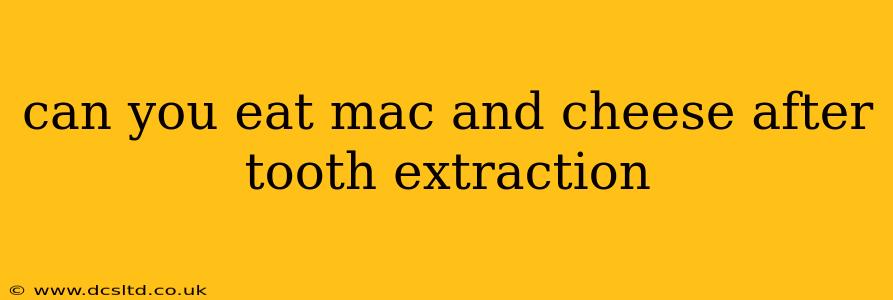Can You Eat Mac and Cheese After Tooth Extraction? A Guide to Post-Extraction Diet
Having a tooth extracted can be a bit of a pain (literally!), and choosing the right foods afterward is crucial for a smooth recovery. One popular comfort food often comes to mind: mac and cheese. But is it a safe bet post-extraction? The answer is nuanced and depends on several factors. Let's explore!
Is Mac and Cheese Okay After Tooth Extraction?
The short answer is: it depends. While mac and cheese is undeniably comforting, its suitability after a tooth extraction hinges on its consistency and your specific situation. Generally, you should avoid anything that requires excessive chewing or could irritate the extraction site.
The good: Mac and cheese, when prepared correctly, can be a relatively safe option. If it's creamy and smooth, requiring minimal chewing, it can provide much-needed calories and nutrients during your recovery. The soft texture is gentle on the extraction site and reduces the risk of dislodging the blood clot.
The bad: However, if your mac and cheese is chunky, contains hard noodles, or has crunchy bits of bread crumbs or other additions, it’s a no-go. These can get lodged in the extraction socket, causing pain, infection, and potentially delaying healing.
What Kind of Mac and Cheese is Best?
Ideally, opt for a velvety smooth, creamy mac and cheese with very soft noodles. You might even consider blending it slightly to ensure an ultra-smooth consistency. Homemade versions give you better control over texture and ingredients, avoiding potentially problematic additives.
What are the risks of eating mac and cheese too soon after a tooth extraction?
The primary risk lies in the potential for irritating the extraction site. This can lead to:
- Dry Socket: A painful condition where the blood clot at the extraction site dislodges, exposing the bone and nerves. While mac and cheese itself won't cause dry socket, forceful chewing or the presence of food particles could contribute to its development.
- Infection: Food debris can harbor bacteria, increasing the risk of infection in the vulnerable extraction site. This is especially true if the mac and cheese isn't very smooth.
- Pain and Swelling: Chewing, even gently, can increase pain and swelling in the area.
What other foods can I eat after a tooth extraction?
Your post-extraction diet should focus on soft, easily digestible foods. Good options include:
- Yogurt: Provides probiotics which are beneficial for gut health, potentially aiding overall recovery.
- Applesauce: Soft and easy to swallow.
- Scrambled eggs: Protein-rich and easy to chew.
- Smoothies: Nutrient-packed and require no chewing.
- Soups (broth-based): Avoid those with chunky vegetables or solid ingredients.
- Mashed potatoes: A classic soft food option.
When can I return to a normal diet after a tooth extraction?
This varies depending on the individual and the complexity of the extraction. Generally, you can gradually introduce more solid foods after a few days, but it's best to listen to your body and your dentist's advice. Your dentist will provide specific recommendations based on your healing progress.
Should I consult my dentist before eating mac and cheese after my tooth extraction?
While this article provides general guidelines, it is always best to consult your dentist or oral surgeon. They can provide personalized recommendations based on your specific situation and the type of extraction performed. They'll be able to tell you when it's safe to incorporate different food textures into your diet.
Remember, prioritizing your oral health and following your dentist's instructions are essential for a successful recovery. While mac and cheese can be a part of your recovery diet, ensuring it’s prepared appropriately and listening to your body are crucial factors to consider.
